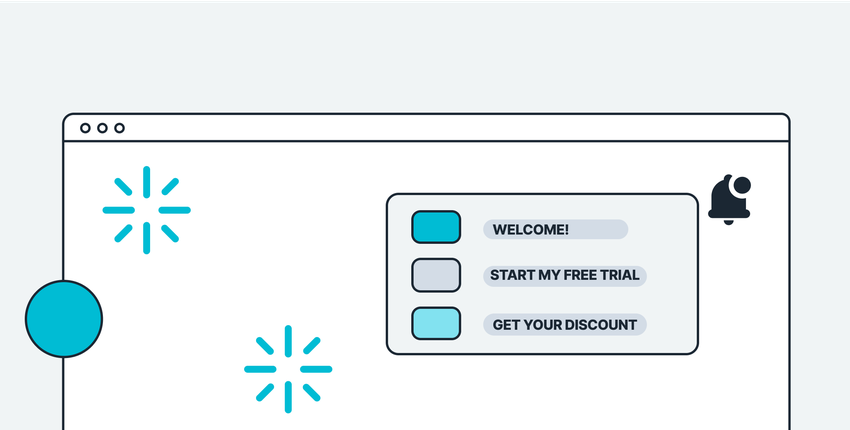
Last updated Thu Jun 12 2025
How to Grow an Ecommerce Business [Guide 2025]
The ecommerce world has been on an absolute tear lately. Multiple sources say that global online retail sales hit over $5 billion and are projected to increase.
But what's driving all this growth? Well, it's a combination of people getting more comfortable shopping online, amazing new technologies, and the sheer convenience of being able to buy stuff with just a few taps on your phone.
Whether you're brand new to ecommerce or you've already got an online store up and running, this guide has everything you need to take your business to the next level. We'll cover the essential steps to get your store set up, build an awesome brand, attract tons of customers, and scale your operation to become the dominant player in your market.
Sounds good? Let's dive in!
Show the right message to the right visitor
Retain customers with AI-powered product recommendations and targeted marketing offers
★ Consider these Shopify success stories or these Ecommerce case studies if you'd like to see examples of successful ecommerce growth tactics.
Laying the Foundation for Your Ecommerce Business
Choosing the right ecommerce platform
The first big decision you'll need to make is which e-commerce platform to use for your online store. Some of the most popular options out there are Shopify, BigCommerce, WooCommerce, and selling through Amazon.
Each one has its own unique features and benefits:
| Platform | Pros | Cons |
|---|---|---|
| Shopify | Easiest to use, tons of apps for marketing and store management | Monthly payments, get increasingly complicated fast |
| BigCommerce | Packed with advanced ecommerce tools, multi-channel selling capabilities | Steep learning curve, limited store design options |
| WooCommerce | Highly customizable, free and open-source | Technical knowledge often required |
| Amazon | Access to a massive customer base, established reputation | Limited branding and control over customer experience |
Think about your technical skills, your budget, and your long-term goals. That will help you figure out which platform is the best fit. Do a little research, make a pros and cons list, and go with the one that seems like the perfect match for your business.
Reviews of ecommerce platforms and apps:
Doing market and target audience research
Before you even start building your online store, you need to really understand your target customers. Who are they? What are their pain points? Where do they hang out online? Doing thorough market research is key.
Dive into customer reviews, browse forums and social media groups, and check out industry reports. This will help you define your ideal customer profile - their age, location, interests, shopping habits, and more. You should also analyze your competitors to identify gaps in the market you can capitalize on.
Consider these resources for research:
Customer reviews on competitors' websites
Pro tip: Customer reviews on your competitors’ stores show exactly what people love and hate about your competitors products - this is a treasure trove of insight—use it!
Setting up your online store
Okay, once you've chosen your platform and done your research, it's time to actually set up your online store. Remember, this is your virtual storefront, so you want it to make a great first impression.
Pay close attention to the layout, navigation, and overall look and feel. Your product pages should be visually stunning, with high-quality images, detailed descriptions, and strategic pricing. Make it easy for customers to find what they're looking for and complete their purchases.
This website conversion funnel guide will help you optimize your site for sales.
For design inspiration, check out:
Doing ecommerce SEO
Search engine optimization (SEO) is absolutely crucial for an e-commerce business. If you can get your website and product pages ranking well on Google, you'll attract way more potential customers.
Start by doing keyword research to figure out the terms and phrases people are searching for in your industry. Then, sprinkle those keywords throughout your website content, product descriptions, and meta tags. Also, create informative, SEO-optimized blog posts and videos to position yourself as an expert.
Ensuring privacy and security
In the digital age, online security and privacy are major concerns for customers. Make sure you have robust security measures in place, like SSL encryption, secure payment processing and identity theft protection. You should also comply with data privacy regulations like GDPR and CCPA to build trust with your audience.
Prioritizing safety and privacy isn't just the right thing to do - it can give you a big competitive edge too. Customers will feel way more comfortable doing business with you if they know their information is protected.
Building Your Brand and Customer Base
Developing a strong brand identity
Your brand is the foundation of your entire ecommerce business. It's how people recognize and connect with your products and messages. So you want to craft something unique, visually appealing, and deeply reflective of your business's personality and values.
Start by defining your brand identity - your logo design, color scheme, tone of voice, and overall aesthetic. Make sure it all works together seamlessly to create a cohesive, memorable brand experience.
How to develop a brand voice:
Ecommerce copywriting guide will show how to write to get great results
How to write product descriptions will help create engaging and unique texts
Use onsite marketing
Onsite marketing is a strategy for engaging with and converting website visitors by tailoring campaigns to their specific behaviors and collected data: including their pathways to the site, past purchases, and currently viewed pages.
A standout aspect of onsite marketing lies in its ability to combine various visitor engagement tools—such as popups, notification bars, chatbots, landing pages, and embeds—into a unified strategy aimed at addressing the unique needs of distinct visitor segments or even individual visitors.
| Traditional way | Onsite marketing way |
|---|---|
| Show all marketing messages right away | Show messages only when visitors meet pre-defined criteria (visit a certain page, add a product to the cart, etc. |
| Shoe the same marketing campaigns to all visitors | Make campaigns to different visitor groups (new, returning, paid, organic, registered, etc.) |
| Use all onsite tools, such as chatbots and popups, often to promote the same offer | Use onsite tools strategically to target specific visitor groups or different goals |
| Use basic, common strategies to engage your visitors, such as a newsletter signup popup across all pages | Use a range of campaign formats, often based on customer browsing behavior and purchasing history |
Here's how onsite marketing different from other marketing dimensions:
Leveraging social media
Social media marketing on platforms like TikTok, Instagram, and Facebook offers an incredible opportunity to build brand awareness, engage with your audience, and drive traffic to your online store.
Identify the social channels where your target customers hang out the most, and start creating a content strategy to connect with them. Use a mix of product showcases, educational posts, user-generated content, and collaborations with influencers. The key is to show up consistently and provide value.
Research shows that many mid-sized Shopify stores also embed Instagram and TikTok content on homepages:
Using email marketing
Email marketing is one of the most effective ways to nurture and retain new customers So, building a robust email list should be a top priority.
Use email capture tools like to capture email addresses through website popups and other lead generation strategies. Then, keep those subscribers engaged by sending them valuable content, exclusive offers, and updates on your products. Segment your list to deliver super personalized messages that resonate.
For advice on building an email list, see Blume case study (an ecommerce business converts 5% of its traffic into leads).
Consider these 10+ ways to collect emails on your ecommerce website.
Or choose among these 8 email list building tools to get started right away.
Taking advantage of customer reviews
Encourage your customers to leave feedback, and make sure you respond to both positive and negative comments. Use that information to continually improve your products and services.
Showcase your best reviews prominently on your ecommerce website (product pages, product menu pages, dedicated pages for reviews, and even ecommerce popups)—they'll work as powerful social proof to build trust with new potential customers. Pay close attention to any recurring themes or pain points you can address.
Advanced Marketing Strategies for Growth
Content and SEO
Creating high-quality, informative content is a great way to drive targeted traffic to your online store and position yourself as an authority in your industry. Think blog posts, product guides, recording videos - anything that provides real value to your target audience.
Here are some of the most common content examples in ecommerce right now:
Do your keyword research to understand what people are searching for, then craft content that answers their questions and solves their problems. Make sure to optimize everything for the search engines too, so you can rank higher and get found more easily.
Tools like Ahrefs and Jasper help create and optimize content (product descriptions, blog posts, etc.) to deliver the best SEO and search intent results.
Influencer partnerships
Collaborating with influential figures in your niche can be an awesome way to reach new audiences and boost your credibility. Influencer marketing can be pretty pricey, with a single sponsored post costing around $100 per 10,000 followers. But if you find the right partners, it can definitely pay off.
Look for influencers whose values and audience align with your brand. Work with them on content, product reviews, or even co-created campaigns to tap into their established community.
Automation and optimization
As your ecommerce business grows, marketing automation tools can help you streamline your marketing efforts and maximize efficiency.
For example, you can automate the process of generating leads by integrating your popup software (like Wisepops) with email marketing software (like Klaviyo):
Maximizing Sales and Customer Loyalty
Pricing and AOV increase strategies
Finding the right pricing strategy is crucial. You want to strike a balance between being competitive and still making a healthy profit. Do your research on production costs, competitor pricing, and customer perceptions of value.
Also, don't forget about upselling and cross-selling techniques. These can be great ways to increase your average order value and boost your overall sales pipeline. Suggest complementary products, offer bundle deals, or highlight premium versions of items in the customer's cart.
More ways: 10+ ways to increase average order value
Ideas for growing your sales:
20 discount code ideas (for any kind of sale or marketing offer)
How to make Shopify upsell popups (how to share upsell offers with popups)
20 ways to increase ecommerce sales [+examples] (many easy enough to implement today)
Smooth checkout process
Make it as easy as possible for customers to complete their purchases. Offer multiple payment options, minimize form fields, and provide clear instructions. A streamlined, user-friendly checkout experience can go a long way in reducing cart abandonment.
Loyalty programs
Retaining existing customers is just as important as acquiring new ones. Implement a great loyalty program to keep people engaged and encourage repeat business. Consider a points-based system where customers earn rewards for purchases, referrals, and other actions.
Offer perks like free shipping, early access to new products, or exclusive discounts to really build customer loyalty. The goal is to foster a strong sense of community and make your customers feel valued.
Get useful tips:
Leveraging customer data
Collecting and analyzing customer data and feedback is key to continually improving your products, services, and overall customer experience. Use surveys, reviews, and website analytics to gain insights into your audience's preferences, pain points, and shopping behaviors.
Just ensure you're handling all that sensitive information ethically and in compliance with privacy regulations. Protect customer data, be transparent about how you're using it, and give people control over their personal information.
Scaling Your Ecommerce Business
Expanding to new markets
As your business grows, look for opportunities to reach new demographics and enter untapped markets. Conduct thorough research to identify promising segments based on factors like location, age, income level, and purchasing habits.
Adapt your product offerings, marketing tactics, and customer service to cater to the unique needs and preferences of these emerging audiences. Careful planning and execution will be crucial to successfully penetrating new markets.
Prioritizing CX and UX
Maintaining an exceptional customer experience (CX) and user experience (UX) is critical as you scale your e-commerce operation. Continually evaluate and optimize your website, product pages, and overall customer journey.
Invest in user testing, collecting customer feedback, and data analysis to pinpoint areas for improvement. Implement features like personalized product recommendations, streamlined navigation, and mobile-responsive design to keep people engaged and coming back.
A great idea is to leverage a customer service chatbot that will help you automate customer support and enhance the overall customer experience:
Diversifying your products
To drive sustainable growth, consider expanding your product lineup and exploring new markets. This can help you capture a larger share of your target audience and reduce your reliance on a single revenue stream.
Analyze industry trends, customer preferences, and your own capabilities to identify potential new product categories or complementary offerings. Carefully evaluate the risks and opportunities, then develop a strategic plan to roll out new products or enter new markets.
Automating repetitive processes
As your business scales, leveraging automation and digital marketing tools becomes crucial to streamlining operations, boosting efficiency, and freeing up your time for strategic initiatives. Tools like Wisepops can help you automate lead capture, email marketing, and customer engagement.
Implement marketing automation workflows to generate leads, cross-sell to existing customers, and re-engage inactive users. Wisepops' features, like email capture forms and triggered pop-ups, make it easy to integrate these automation efforts into your overall digital strategy.
Measuring Success and Optimizing Your Strategy
Tracking key metrics
To make data-driven decisions and continually improve your e-commerce business, you need to regularly track and analyze key performance indicators (KPIs). Things like website traffic, conversion rates, average order value, and customer lifetime value will give you a clear picture of how you're doing.
Set up a comprehensive dashboard to monitor the health of your online store. Continuously review these KPIs, identify trends, and make adjustments to your marketing, operations, and product strategies as needed.
Staying on top of trends
Maintaining a strong SEO presence and keeping up with the latest e-commerce marketing trends is crucial for long-term success. Google's search algorithms, customer behaviors, and industry best practices are constantly evolving, so you have to stay agile.
Keep a close eye on changes. For example, refresh your store design to web design trends, and keep an eye on ecommerce SEO tactics to ensure your business remains visible, relevant, and competitive.
These ecommerce trends in 2024 will help you stay up to date.
Ongoing optimization
Don't just "set it and forget it" when it comes to your marketing campaigns. Regularly review and optimize to maximize your return on investment (ROI). Test different strategies, analyze the results, and make refinements to keep improving performance over time.
Experiment with various channels, messaging, and targeting to identify the most effective combinations for your business. Leverage A/B testing, multivariate analysis, and other optimization techniques to fine-tune your campaigns.

Asphalte used A/B testing to increase the conversion rate of lead generation campaigns from 15% to 25%
Read Asphalte case study (also available in French)
Getting inspired by ecommerce success stories
Learning from others is one of the best ways to grow your own ecommerce business. You can find our effective tactics, strategies, and campaigns and adapt them to your needs.
Consider these ecommerce case studies:
Blume converts 5% of visitors (if you’re looking for ideas on how to create high-performing lead capture campaigns)
Soi Paris’ Egg hunt campaign (in this one, a clothing business got 233 discount code redeemed by customers in 48 hours—could be helpful if you need some creative ways to sell more during holidays)
OddBalls generated £50k with one campaign (in this one, a popular underwear brand achieved success with their discount code campaign for new customers).
Wrapping Up
By following the steps in this guide, you'll be well on your way to building a thriving, dominant e-commerce business. Remember, the key is to stay agile, adaptable, and always keep your customers at the forefront.
If you’d like to keep learning, consider these guides from Wisepops blog:

Irina Maltseva
Irina Maltseva is a Growth Lead at Aura, a Founder at ONSAAS, and an SEO Advisor. For the last eight years, she has been helping SaaS companies to grow their revenue with inbound marketing.
Related articles

4/22/2025
Learn how to use onsite notifications on your website in this in-depth guide with ideas and examples.

5/29/2024
Learn how to manage leads and sell based on the example of how Wisepops uses Zapier integrations.
